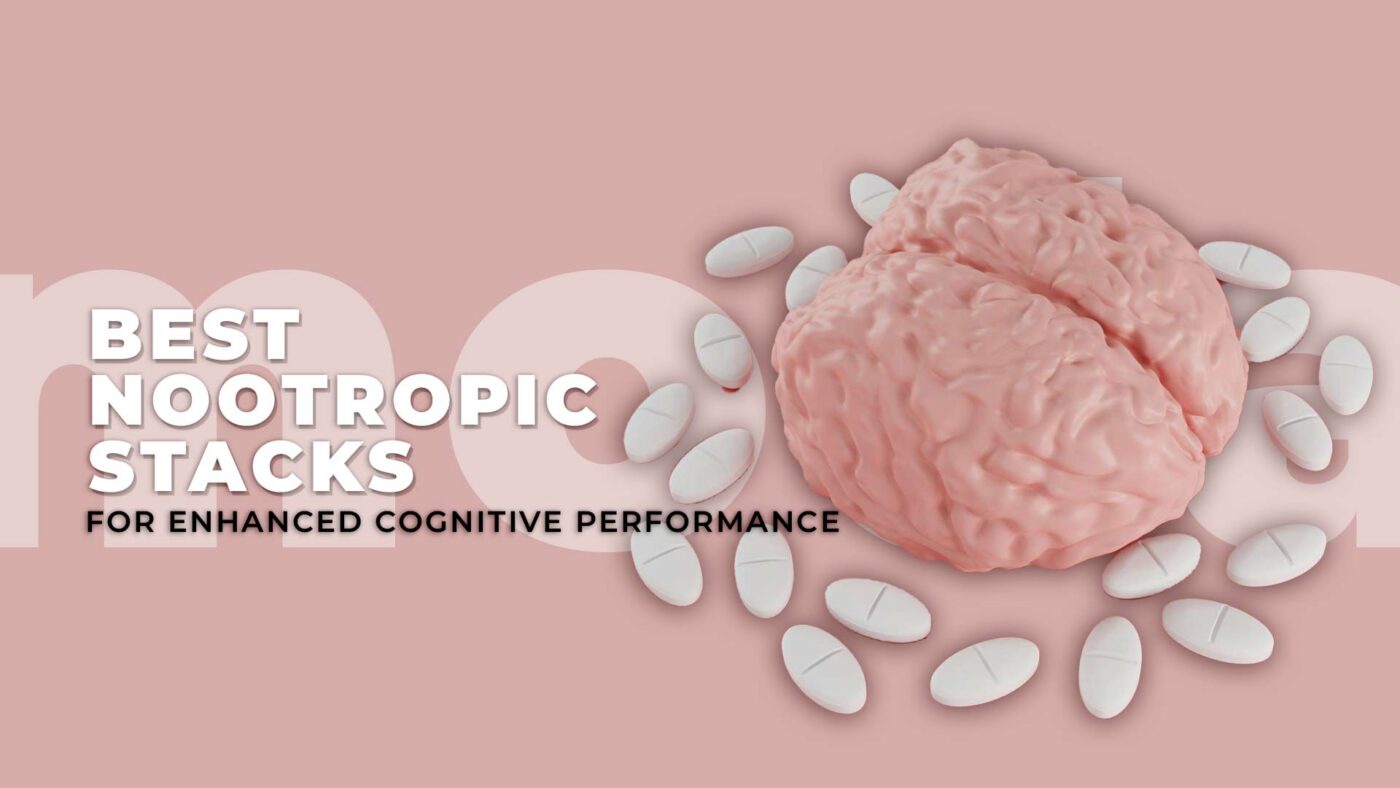Best Nootropic Stack for Cognitive Enhancement

Nootropic stacks are rapidly becoming the preferred method for enhancing performance among students in top colleges and universities, as well as in the workplace. This is because they have the potential to produce more powerful and longer-lasting effects than single nootropics or other types of smart drugs. Whether you’re new to nootropics or have been experimenting with them for some time, this guide will provide you with the information you need to get started with nootropic stacks, as well as introduce you to some of the latest and best nootropic stacks designed for specific uses and types of nootropics.
Table of Contents
What Are Nootropic Stacks?
Nootropic stacks refer to combinations of nootropics with other nootropics. By combining two or more nootropics, a nootropic stack is formed. Nootropic stacking can either entail a combination within the same type of nootropic, such as a mix of Racetams or Natural nootropics, or a mixture of different types of nootropics, such as blending Racetams with Natural nootropics or mixing Cholines with Ampakines. Alternatively, one may blend Racetams with Cholines and Vitamin-B derivatives.
Nootropic stacks can come in various combinations, regardless of whether one combines different types of synthetic nootropics, natural nootropics, or a blend of both. The issue is that with the multitude of nootropics available, it can be perplexing and overwhelming to comprehend how each nootropic functions, what it is best to mix it with, and how much to safely take.
To save you time, effort, and possibly even some money and frustration, we have provided below a list of some of the best nootropic stacks for specific types of nootropics, as well as the best nootropic stacks for specific needs.
How Do Nootropics Work?
Nootropics are substances or supplements that are known to improve cognitive function, including memory, inspiration, drive, and focus. They are also commonly referred to as “smart drugs.”
There has been significant research on the effects of nootropics on the brain, with various pathways and processes involved in their effects on cognitive function, such as the dopaminergic system. Nootropics have been shown to help with memory problems related to diseases such as Alzheimer’s, Parkinson’s, and Huntington’s, which disrupt the same neural circuits that nootropics target. As a result, modern nootropics are developed with a focus on specific pathways to target.
Furthermore, natural nootropics like Ginkgo biloba have been extensively studied for their positive effects. This review focuses on the primary pathways, including the dopaminergic and cholinergic systems, as well as the roles of amyloid precursor protein and secondary messenger in enhancing cognitive function.
Pros and Cons of Nootropic Stacks

The advantages of using nootropic stacks over single supplements include
- The ability to enhance cognitive effects beyond what a single supplement can achieve due to the different mechanisms of action of nootropics.
- Additionally, a well-designed stack can counteract the adverse effects of individual supplements.
- Multiple benefits can be obtained simultaneously, such as improved memory recall, reduced anxiety, better neuronal growth, and increased energy.
However, there are some drawbacks to consider when it comes to stacking.
- Firstly, it can be more expensive due to using a combination of different supplements.
- Secondly, only experienced individuals should design custom nootropics, as experimenting without adequate knowledge may lead to creating an ineffective stack, overdosing, or adverse health issues.
- Thirdly, improper use of stacks can lead to dependence and other side effects.
- Finally, weighing and mixing your own stack can be more cumbersome than using a preformulated one.
Difference between Nootropics and Nootropic Stacks
Nootropics are compounds that enhance cognitive functions, energy levels, and other bodily functions by acting on the central nervous system. Several different substances can produce nootropic effects, with each targeting distinct processes and components of the body and brain. Nonetheless, the individual benefits of these nootropics are usually moderate. To achieve more robust, varied, and long-lasting effects, nootropic stacks combine two or more ingredients.
Why Go for Nootropic Supplements?
Stacking nootropics is popular among users as it allows them to maximize the full potential of each ingredient. Since nootropics have different mechanisms of action and effects on the brain, combining two or more nootropics can provide a wider range of benefits. For instance, one may combine a nootropic that enhances cognition with another that improves attention and elevates mood. Whether you are a college student looking to boost your brainpower and memory or a professional aiming to improve focus and reduce anxiety, there is a nootropic stack suitable for your needs. Each of the recommended stacks listed below is specially formulated to achieve the desired effects as efficiently as possible.
5 reasons why people choose to stack nootropics:
- Amplify the effects of each nootropic when they are combined.
- Complement the benefits of the combined nootropics.
- Create greater synergy between the different nootropics.
- Minimize or offset some of the side effects that come with certain nootropics.
- Take advantage of the additional health benefits that come with other nootropics.
There are numerous reasons why individuals may opt to take nootropic supplements. Some use them to enhance their cognitive abilities and memory, while others take them to heighten focus and concentration. Additionally, some use them to augment their energy levels or assist with weight loss. Ultimately, the decision to take nootropic supplements is a personal one, but it is crucial to recognize that these supplements can have potent effects on your body and mind. Hence, it is important to seek advice from a physician before commencing any supplement routine, particularly if you have any underlying health issues.
How to Make Nootropics Effective?
Starting with a single nootropic is simple, but combining multiple nootropics to achieve desired results can be challenging. To create an effective and safe nootropic stack, it is important to consider the following factors, whether you are buying a pre-made stack or making your own:
Synergy: The primary goal of stacking nootropics is to enhance the effects of each component. For instance, combining aniracetam with CDP Choline can improve cognition by increasing the levels of acetylcholine, a neurotransmitter responsible for attention, memory, and motivation. CDP Choline helps to amplify the cognitive effects of aniracetam and protects the brain as an anti-oxidant.
Target a specific outcome: Different nootropics have different properties, such as promoting memory and learning, enhancing focus and concentration, or reducing stress and anxiety. It’s better to stack nootropics that work together to improve a specific cognitive effect.
Avoid negative interactions: Good stacks should contain components that work together without canceling each other out. For example, L-Theanine mitigates the negative effects of caffeine, but it may also reduce its energizing effect. Therefore, combining complementary nootropics is key to ensuring an optimal stack.
Simplicity: The best nootropic stacks usually have two to five different components. A minimum number of nootropics in a stack makes it easier to monitor and adjust each ingredient’s impact while keeping costs low and reducing the risk of adverse interactions. The primary goal should always be to target a specific outcome or effect.
How to Use Nootropic Stacks Safely?

To start using nootropic stacks, there are two primary options available.
The first option is to use pre-made stacks that are available from manufacturers. These pre-made stacks are a great choice for beginners who are new to the world of nootropics. They are readily available off-the-shelf and are designed to serve a specific purpose. They provide an excellent introduction to stacking and are more convenient than having to weigh and mix your own stacks.
Alternatively, you may choose to create a self-formulated stack. Unlike pre-made stacks, a self-formulated stack allows you to experiment with different nootropics, dosages, and components of the stack. Note that only experienced and knowledgeable individuals should attempt to create their own stack. This is necessary to ensure that the correct ingredients are mixed in the appropriate amounts to achieve the safest and most effective results.
True Help vs. Placebo Effect
Assessing the efficacy of nootropics can be a challenging task, as one needs to gauge the actual functioning of their own brain while facing a diverse range of tasks. Moreover, this challenge is further complicated by the placebo effect.
The placebo effect is the notion that the belief that something is changing leads to an actual change. For instance, if you believe that an antidepressant is effective, it is more probable to work than if you were skeptical about it.
The same principle applies to nootropics. If you approach this area with the notion that it can and will enhance your cognitive abilities, it is more likely to do so.
Best Nootropic Stacks
Modafinil
According to a joint study by Harvard Medical School and Oxford University, modafinil is a potent nootropic that enhances creativity, learning, planning, and decision-making. Another study by Imperial College London found that sleep-deprived surgeons who used modafinil were less impulsive and better at planning and redirecting their attention. To maximize the benefits of modafinil and achieve even better results, here is the recommended nootropic stack:
- 300mg of modafinil taken once every morning
- 100mg of caffeine to enhance the stimulant properties of modafinil
- 30mg of Yohimbine HCL, a natural stimulant, to keep you energized throughout the day
- 500mg of Alpha GPC to boost choline levels and enhance the effects of modafinil
- 1,000mg of Fish Oil, which contains essential Omega-3 fatty acids that promote better brain health and functionality.
Caffeine and L-Theanine
The combination of caffeine and L-theanine is one of the most well-supported nootropic stacks, according to scientific research. Caffeine, a commonly consumed stimulant known for promoting mental awareness and concentration, has also been shown to potentially prevent cognitive decline in healthy individuals. L-theanine, on the other hand, has calming effects without causing drowsiness. When consumed together, the anxiogenic effects of caffeine are diminished, as shown in a 2008 study. This combination has been shown to be particularly effective for tasks that require cognitive demands such as studying or problem-solving.
Piracetam
Piracetam, a popular nootropic developed in the 1960s, has been successful in improving cognitive function, particularly in seniors experiencing cognitive decline. Piracetam promotes enhanced cellular membrane fluidity, leading to cognitive improvements. However, some users experience headaches or other mild side effects. The addition of Choline, a precursor molecule for the neurotransmitter acetylcholine, can increase the effectiveness of Piracetam and other Racetam nootropics. This combination is considered one of the best nootropic stacks for focus and memory.
PAO stack
The PAO stack, which includes Piracetam, Aniracetam, and Oxiracetam, is another effective nootropic stack. Each Racetam has its own unique benefits, and when consumed together, users can experience a full range of mental benefits. While research on nootropics is still ongoing, current studies indicate that these drugs can be safe and effective when consumed in proper dosages. As immediate cognitive enhancers and long-term treatments for various conditions, nootropics hold great promise.
Best Nootropic Stacks for Studying

The most effective combination of nootropics for students is one that enhances memory formation and recall, as well as attention, focus, and motivation. Studying can be mentally demanding and lengthy, so it’s important to take advantage of the following nootropic stack to optimize your studying:
A daily dosage of the following should be included in the best nootropic stack for studying:
- Piracetam (300-600mg): A highly potent study aid that improves memory and information retention. It can be taken in one or two daily doses.
- Alpha GPC (300-600mg): Boosts acetylcholine in the brain and works synergistically with racetams to increase focus and memory while counteracting negative side effects such as headaches.
- L-Theanine (200mg): Reduces stress, enhances focus, and promotes relaxation and better sleep. It can also alleviate the jittery effects of caffeine, which you may be taking to stay alert.
- Lion’s Mane (1-2 capsules): A natural nootropic that increases Nerve Growth Factor levels and improves brain functions such as cognition and memory formation.
- Ashwagandha powder (450-900mg): A natural supplement that enhances the body’s ability to cope with stress, which is especially important during exams.
Vinpocetine (20-30mg) can be taken before a test to improve memory, and caffeine (100mg) can be taken with racetams to boost focus and mental performance. Additionally, taking a multivitamin and omega-3 supplements can further enhance brain health and well-being.
Best Nootropic Stacks for Focus and Energy
To maximize mental focus and energy with nootropics, it’s recommended to use a combination of racetams, choline boosters, and natural supplements that increase mental focus and energy. The following stack is one of the best available:
- Piracetam (800mg to 1,200mg): Taken daily, this nootropic significantly improves cognitive ability and is well-tolerated, making it ideal for beginners.
- Centrophenoxine (500 to 1,000mg): A source of choline with neuroprotective properties that works well with racetams to enhance cognition, focus, and attention.
- Alpha GPC (300 to 600mg): Another cholinergic compound that enhances the effects of racetams.
- L-Tyrosine (250mg to 500mg): Contains high levels of L-Dopa, which boosts dopamine levels to improve mood and energy.
- Sulbutiamine (400mg): Renowned for increasing alertness, focus, attention, and memory, while also improving mood.
For even better results, Piracetam can be substituted with Aniracetam or Noopept, which are more potent. Synthetic nootropics like Modafinil, Adrafinil, or Phenylpiracetam are even more effective at boosting focus and attention, making them suitable for high-stress situations or exams, but are less suitable for daily use. However, the recommended stack above is less potent and suitable for everyday use.
Best Nootropic Stacks for Depression
Nootropics have been known to possess the potential to enhance mood and reduce stress and anxiety. With the growing interest in nootropics for managing depression, the following is one of the most effective nootropic stacks for combating depression:
- 1,000mg of Aniracetam: This racetam is renowned for its ability to improve mood and provide a powerful surge of positive mental energy.
- 200mg to 300mg of 5-HTP: This nootropic is a precursor to serotonin, the neurotransmitter responsible for regulating mood. 5-HTP counteracts depression without causing adverse effects.
- 200mg of L-Theanine: This nootropic combats depression by reducing the levels of cortisol, the stress hormone.
- 15 to 30g of Mucuna Pruriens: This natural nootropic contains high levels of L-Dopa, a precursor to dopamine, a neurotransmitter that regulates mood.
- 250 to 350 mg of Phenibut: This nootropic is a derivative of GABA, a neurotransmitter that helps to prevent stress and lower anxiety.
- 300 to 500mg of Valerian Root: This natural nootropic elevates the levels of GABA, which helps to reduce stress.
Takeaway
Combining multiple nootropics into a stack can produce more powerful and harmonious results than taking them individually. The beneficial effects of each nootropic can complement and enhance each other, while any negative side effects can be mitigated or eliminated altogether. Thus, if you’re considering the health benefits of nootropics, it’s important to focus on using synergistic nootropic stacks to maximize their potential benefits.
References
- Segall, L, and E. Fink. “Are smart drugs driving Silicon Valley?” CNNMoney. Cable News Network, 26 Jan. 2015.
- Cederström, C. “Like It or Not, “Smart Drugs” Are Coming to the Office.” Harvard Business Review. N.p., 19 May 2016.
- “Many Ivy League Students Don’t View ADHD Medication Misuse as Cheating.” American Academy of Pediatrics. N.p., 14 May 2014.
- Nehlig, A. “Is caffeine a cognitive enhancer?” Journal of Alzheimer’s Disease: JAD. U.S. National Library of Medicine, n.d.
- Nobre, A. C., A. Rao, and G. N. Owen. “L-theanine, a natural constituent in tea, and its effect on mental state.” Asia Pacific Journal of Clinical Nutrition. U.S. National Library of Medicine, n.d. 2008
- Owen, G. N., H. Parnell, E. A. De, and J. A. Rycroft. “The combined effects of L-theanine and caffeine on cognitive performance and mood.” Nutritional Neuroscience. U.S. National Library of Medicine, Aug. 2008.
- “Review of ‘smart drug’ shows modafinil does enhance cognition.” University of Oxford. N.p., 20 Aug. 2015.
Shafazand, S. “Effect of Pharmacological Enhancement on the Cognitive and Clinical Psychomotor Performance of Sleep-Deprived Doctors: A Randomized Controlled Trial.” Yearbook of Neurology and Neurosurgery 2012 (2012): 160–61
Disclaimer
HisBlue is not a substitute for professional medical care or advice from your doctor. The health information on the HisBlue website is general and provided for your information only. We have ensured our content is accurate and current, with reviews by expert doctors. However, we cannot guarantee its accuracy or timeliness. This information is not meant to replace the diagnosis, treatment, or judgement of your doctor or another qualified healthcare provider.


